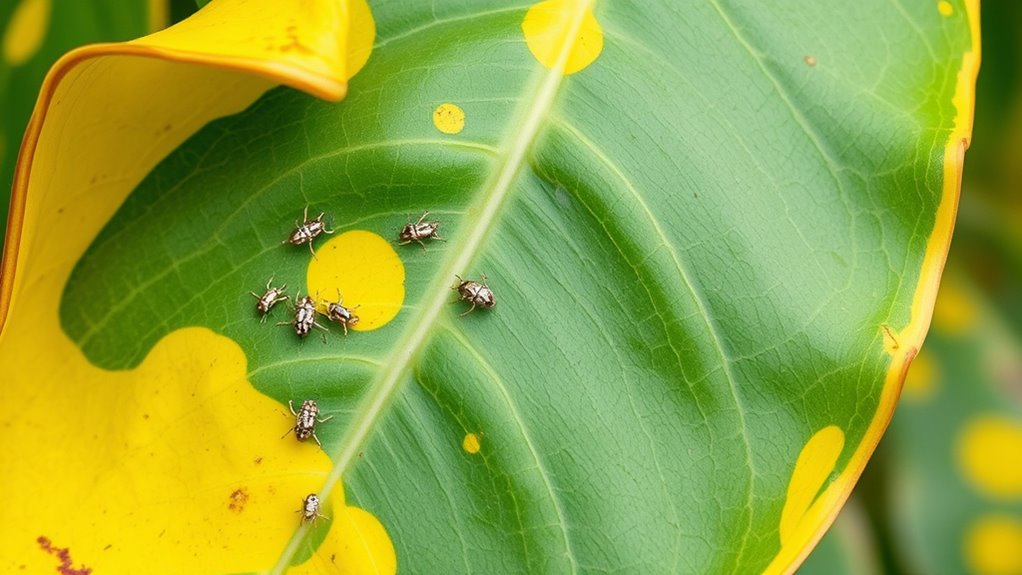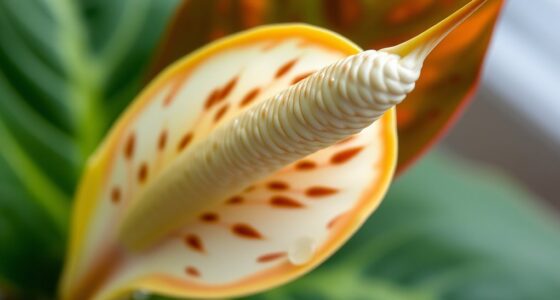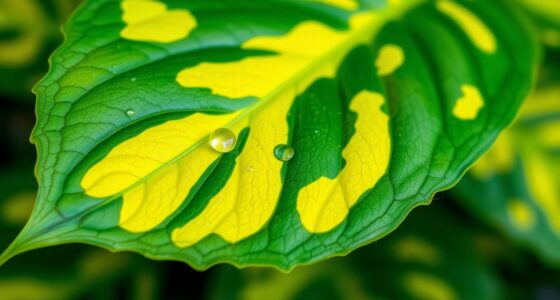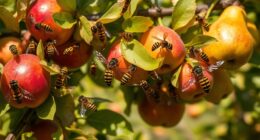If your camellia’s leaves curl, check for pests like tiny, sticky tea scale insects that may cause bumps and sticky residue, or mites that create stippling and curling. Viral infections tend to produce uniform discoloration or streaks across leaves without webbing or sticky spots. Spotting these signs helps you identify the cause. To learn how to distinguish and treat each issue effectively, keep exploring solutions that protect your plant’s health.
Key Takeaways
- Irregular, uneven leaf twisting with webbing and sticky residue suggests pest issues like tea scale or mites, not viral causes.
- Uniform leaf discoloration and streaks typically indicate a viral infection rather than pest damage.
- Presence of tiny insects on leaf undersides and sticky honeydew points to tea scale or mite infestations.
- Mite damage causes stippling and curling, often accompanied by natural predators like ladybugs.
- Viral leaf curl appears as mosaic or streaked patterns and cannot be treated with insecticides.
Recognizing the Symptoms of Leaf Curl in Camellias
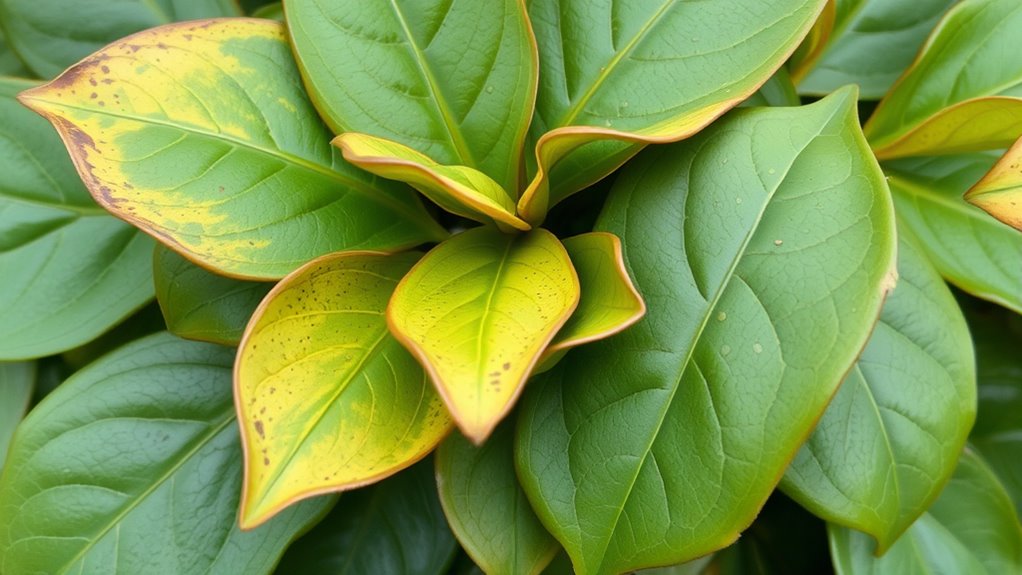
To identify leaf curl in camellias, start by closely examining the foliage for abnormal changes. Look for leaves that are distorted, curled, or misshapen, which can signal underlying issues. Poor soil nutrition often contributes to weakened plants, making them more susceptible to leaf curl. Ensuring your camellias receive proper nutrients helps maintain healthy, resilient foliage. Additionally, review your pruning techniques; improper pruning can cause stress and damage, leading to curled leaves. Remove any affected leaves carefully and avoid excessive trimming that might hinder the plant’s recovery. Consistent monitoring and adjusting soil nutrition, along with correct pruning methods, help you spot early symptoms and prevent the progression of leaf curl. Staying aware of plant health issues and acting promptly can make a significant difference in your camellia’s recovery. Proper soil management is also essential to support overall plant health and prevent stress-induced problems. Stay observant, and act promptly to keep your camellias healthy.
Identifying Tea Scale Infestations and Their Effects

Tea scale infestations often go unnoticed until they cause visible damage because the tiny insects cling tightly to the underside of camellia leaves. You might spot small, swollen bumps or a sticky honeydew coating on leaves, which can lead to sooty mold growth. Poor soil nutrition can weaken your plant’s defenses, making it more susceptible. Regular inspection helps identify early signs of infestation. Effective pruning techniques can remove heavily infested branches, reducing scale populations. Maintaining balanced soil nutrition supports overall plant health and resilience against pests. If you notice sticky residue or distorted leaves, act quickly to check for tea scales. Combining proper soil care with strategic pruning is key to preventing severe infestations and keeping your camellias healthy. Additionally, understanding the contrast ratio of your treatments can help improve your pest management outcomes. For example, selecting treatments with proven efficacy can ensure better results and protect your plants more effectively. Ensuring the proper application methods of insecticidal treatments can significantly enhance their success rate and minimize harm to beneficial insects.
Mite Damage: How Tiny Pests Cause Leaf Curl
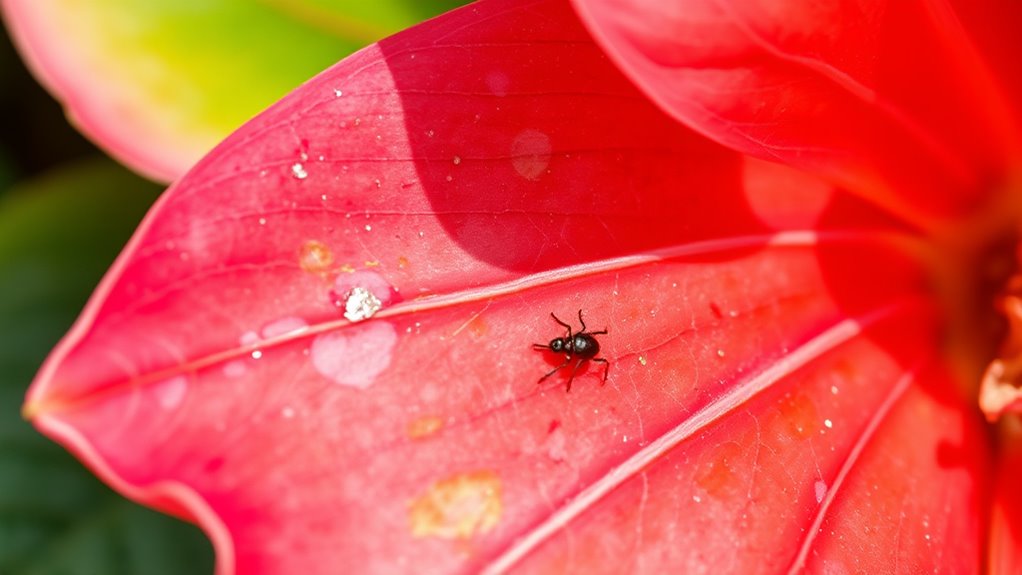
Tiny pests like mites can cause significant damage to camellias by disrupting the leaves’ normal development. When mites feed on your plant, they extract sap, leading to curling, stippling, and discoloration. You might notice the leaf curl early on and wonder what’s causing it. To manage mite damage, consider these tips:
- Encourage beneficial insects like predatory mites and ladybugs that naturally control pest populations
- Use organic sprays such as neem oil or insecticidal soap to target mites effectively
- Regularly inspect your camellias for early signs of infestation
- Keep plants healthy through proper watering and fertilization to reduce stress, making them less attractive to pests
Viral Infections and Their Impact on Camellia Foliage

Viral infections can severely impact camellia foliage, causing distinctive and often unpredictable symptoms. When infected by a plant virus, you might notice leaf discoloration that ranges from mottling and streaks to general chlorosis. These viruses interfere with the plant’s normal cellular functions, leading to abnormal growth and distorted leaves. The discoloration isn’t uniform; it can appear as patches or streaks, making it easier to identify affected foliage. Unlike pests, viruses are not visible to the naked eye and cannot be eliminated with insecticides. The damage from viral infections can weaken the plant over time, reducing flowering and overall vigor. Early detection and proper sanitation are essential to prevent the spread of the virus and protect your camellias’ health. Additionally, understanding the signs of spoilage in related plant materials can help prevent the spread of diseases. Incorporating disease management strategies and practicing proper sanitation can further assist in maintaining healthy plants and minimizing viral transmission.
Visual Differences Between Pest-Induced and Viral Leaf Curl

While viral infections cause characteristic discoloration and distortion in camellia leaves, pest infestations often produce different visual signs. Pest identification relies heavily on observing leaf patterns and damage. Pest-induced leaf curl typically shows irregular or localized curling, with leaves twisting or puckering unevenly. You might notice tiny specks or webbing if mites are involved, or a sticky residue from tea scale. The leaf pattern often remains intact, but the curling is more uneven and sporadic. In contrast, viral leaf curl results in uniform discoloration, mosaics, or mottling across the leaf surface, with distortion spreading evenly. Examining pest damage patterns closely can help distinguish whether pests or viruses are causing the leaf curl on your camellia. Additionally, understanding plant pathogen symptoms can aid in accurate diagnosis and appropriate treatment. Recognizing leaf curling causes is crucial for selecting the correct management approach and preventing further damage.
The Role of Environmental Factors in Leaf Curl Development
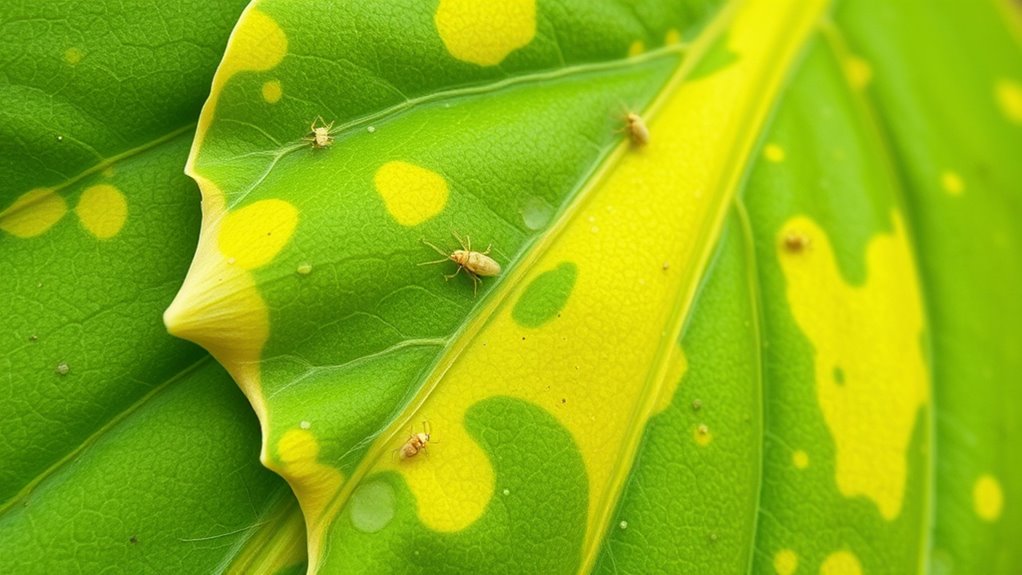
Environmental factors play a significant role in leaf curl development on camellias. High humidity and leaf stress can make plants more vulnerable, while temperature fluctuations can cause rapid changes that weaken leaves. Additionally, intense sunlight can increase fungal risks, further impacting leaf health and structure. Moreover, celebrity transformations often highlight how environmental factors influence appearance and health, emphasizing the importance of proper plant care. Maintaining optimal environmental conditions can help reduce stress and prevent leaf curl issues.
Humidity and Leaf Stress
Humidity levels considerably influence leaf health in camellias, as fluctuating moisture can cause stress that leads to leaf curl. When humidity drops suddenly, your plant experiences humidity stress, which can cause the leaves to curl as a defense mechanism. Low humidity also promotes leaf dehydration, making leaves look shriveled or crispy. To reduce this stress, you can:
- Increase humidity around the plant with a pebble tray or humidifier
- Water consistently to prevent dry soil and dehydration
- Avoid placing camellias in drafts or near heating vents
- Mulch the soil to retain moisture and stabilize humidity levels
- Utilizing self-watering planters can help maintain consistent moisture levels and reduce environmental stress on your camellia. Maintaining optimal humidity is also important for preventing plant stress, which can exacerbate leaf curl issues.
Monitoring humidity helps prevent leaf dehydration and reduces leaf curl caused by environmental fluctuations. Keeping moisture levels stable allows your camellia to stay healthy and vibrant.
Temperature Fluctuations Impact
Fluctuations in temperature can greatly influence leaf curl in camellias, especially when combined with humidity stress. Sudden drops or spikes in temperature cause the plant to react, often resulting in curled leaves as a protective response. Poor soil drainage can exacerbate this issue by stressing roots during temperature swings, limiting water uptake and weakening the plant’s defenses. Additionally, an imbalanced fertilizer schedule can make camellias more vulnerable; excess nitrogen encourages tender growth that’s more prone to curling under temperature stress. To minimize leaf curl caused by temperature fluctuations, ensure your soil drains well and maintain a balanced fertilizer regimen. Stable temperatures and proper soil conditions help camellias better withstand environmental changes, reducing the likelihood of leaf curling related to temperature shifts.
Sunlight and Fungal Risks
Sunlight plays a critical role in the development of leaf curl in camellias, as too much direct exposure can cause heat stress that weakens leaf tissues and triggers curling. Excessive sunlight exposure creates a warm, humid environment ideal for fungal growth, increasing your plant’s risk of infections. To prevent this, control sunlight exposure by providing partial shade during peak sun hours. Good airflow also helps reduce humidity levels around the leaves, lowering fungal risks. Additionally, avoid watering late in the day to prevent prolonged leaf wetness, which encourages fungi. Regularly inspect your camellias for signs of fungal issues and apply preventative fungicides when necessary. Proper sunlight management is key to maintaining healthy leaves and reducing the chances of leaf curl caused by fungal problems. Understanding environmental factors can help you better manage the costs associated with plant care supplies or treatments.
Effective Monitoring Techniques for Camellia Health
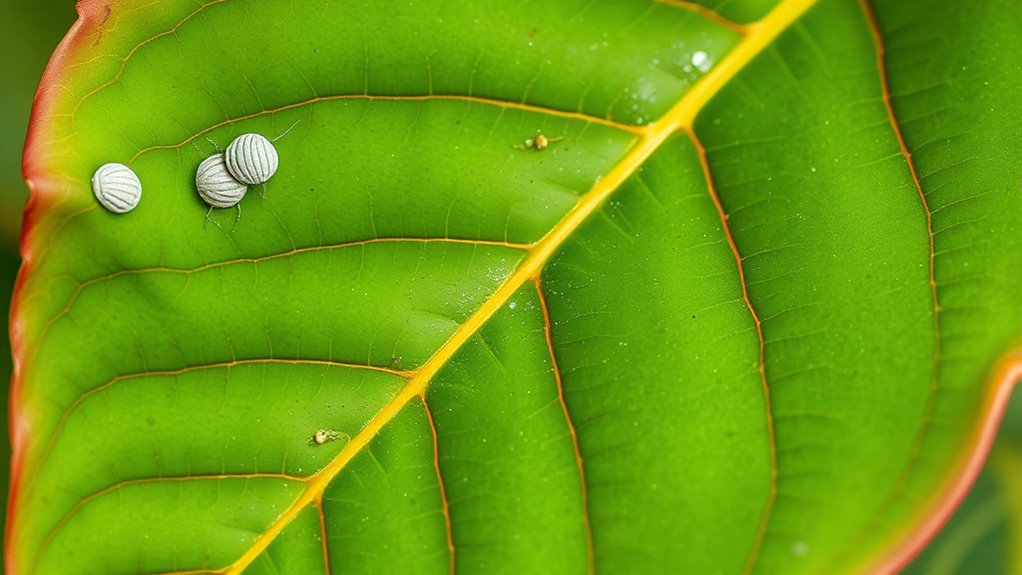
To effectively monitor the health of your camellias, you should regularly inspect the plants for early signs of trouble, such as leaf curl or discolored foliage. Look closely at new growth for abnormalities and check for pests or disease symptoms. Soil testing helps identify nutrient deficiencies that may cause leaf curling or stunted growth. Maintaining balanced soil nutrients reduces plant stress and improves resilience. Use the table below to guide your monitoring:
| Observation | Action |
|---|---|
| Leaf curl or discoloration | Inspect for pests or disease, test soil |
| Wilting or drooping leaves | Check soil moisture and nutrient levels |
| Stunted growth or yellowing | Conduct soil testing for deficiencies |
Regular monitoring allows early intervention, keeping your camellias healthy and vibrant. Being aware of plant nutrition needs can further help prevent issues like leaf curl. Additionally, understanding emerging threats such as pests or viruses can aid in timely management. Recognizing signs of viral infections can also prevent the spread of disease within your garden.
Management Strategies for Tea Scale and Mites

Monitoring for signs of leaf curl and discoloration helps you catch early issues that can weaken your camellias. To manage tea scale and mites, start with targeted control methods. Use pruning techniques to remove infested or heavily affected branches, reducing pest populations and airflow problems. Applying soil amendments, like compost or organic fertilizers, boosts plant health, making camellias more resistant. You can also introduce natural predators, such as lady beetles, to keep pest numbers in check. Regularly inspect leaves for pests and early signs of damage. Avoid over-fertilizing, which can attract pests. Combining these practices creates a healthier environment that discourages pest infestations and supports your camellias’ recovery and resilience.
Preventative Measures Against Viral Spread

Preventing the spread of viral infections in camellias requires proactive steps to limit contact and transmission. First, monitor soil acidity; maintaining proper pH levels helps keep plants healthy and resistant. Slightly acidic soil supports ideal nutrient uptake, strengthening your camellia’s defenses. When pruning, use clean, sharp tools and avoid injuring healthy tissue, as viruses can spread through open wounds. Remove and dispose of infected leaves immediately to prevent the virus from spreading further. Practice good sanitation by disinfecting pruning tools after each cut. Additionally, avoid overcrowding plants to improve air circulation, reducing stress and disease susceptibility. Regularly inspecting your camellias for early signs of infection allows for quick action, considerably decreasing the risk of viral spread.
When to Consult a Professional for Severe Leaf Curl Issues

While taking preventative measures can often keep camellias healthy, severe leaf curl issues may signal underlying problems that require professional intervention. If your plant shows persistent or worsening symptoms despite your efforts, it’s time to seek expert help. A professional can evaluate your camellia’s condition, recommend proper pruning techniques, and suggest soil amendments to improve health. They can also identify issues like viral infections or pest infestations that aren’t easily managed on your own. Consider consulting a specialist if you notice:
- Rapid deterioration despite routine care
- Unusual or widespread leaf curl
- Signs of pests or disease that resist treatment
- Poor soil conditions or nutrient deficiencies
Professional guidance ensures your camellia receives targeted treatment, helping it recover and thrive.
Frequently Asked Questions
Can Leaf Curl Be Caused by Nutritional Deficiencies in Camellias?
Nutritional deficiencies can cause leaf curl in camellias, especially if they lack essential nutrients like magnesium or iron. When these deficiencies happen, your plant’s leaves may curl or distort as a stress response. You should examine your camellia’s soil and consider fertilizing with a balanced, nutrient-rich formula. Addressing nutritional deficiencies helps improve leaf health and prevents further leaf curl, supporting your plant’s overall significance.
Are There Specific Camellia Varieties More Resistant to Leaf Curl?
Did you know some camellia varieties have a 60% higher chance of resisting leaf curl? You’ll want to choose resistant cultivars, which are developed through selective breeding for disease resistance. These cultivars are more likely to stay healthy and vibrant, saving you time and effort. By selecting resistant varieties, you can enjoy beautiful camellias with less worry about leaf curl and other common issues.
How Long Does It Take for Symptoms to Appear After Infestation?
You might wonder how long symptom development takes after infestation. Typically, the infestation timeline varies, but you could start noticing leaf curl symptoms within a few weeks. The exact timing depends on the pest or disease involved. Early detection is key, so regularly inspect your camellias. If you catch the symptoms early, you can take prompt action to manage the issue before it worsens.
Do Natural Predators Help Control Tea Scale or Mite Populations?
You might find it a coincidence that natural predators often help control tea scale and mite populations. Biological control can be quite effective when predator populations are healthy and suited to the pests. These predators, like ladybugs or predatory mites, target pests directly, reducing the need for chemical treatments. Their effectiveness depends on proper habitat and timing, making them a valuable tool in integrated pest management strategies.
Can Leaf Curl Be Reversed Once Symptoms Are Visible?
Once leaf curl symptoms appear on your camellias, recovery potential depends on the cause and symptom progression. If caused by pests or environmental stress, early intervention with appropriate treatments can sometimes reverse or halt the damage. However, if the curl results from a virus, reversal is unlikely, and focus shifts to managing the plant’s health. Acting quickly gives your plant the best chance to recover before symptoms worsen.
Conclusion
By closely monitoring your camellias and catching issues early, you’ll stay one step ahead of leaf curl problems. Whether it’s pests like tea scale and mites or a viral infection, knowing the signs helps you act swiftly. Remember, a problem shared is a problem halved—don’t hesitate to seek professional help if things get out of hand. With attentive care, your camellias can bounce back and flourish like a well-oiled machine.
